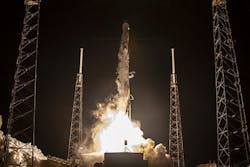Destination space – Where will we be in 2020?
By Paul Kostek, advisory systems engineer, Base2 Solutions
BELLEVUE, Wash., Space exploration has been one of the defining engineering achievements of our lifetime, and we’ve only scratched the surface of what can be accomplished. As we begin preparing to explore other planets and sending civilians into space, the future is bright for space innovation in the new decade. Virgin Galactic, Blue Origin and SpaceX, among others, have all been rapidly building and testing new spacecraft. So, what will 2020 bring? Looking back at 2019, we can draw logical conclusions on innovation in the new year. However, aerospace engineers should be aware of a few potential obstacles to mission success.
In 2020 the long-promised era of commercial space travel may begin in earnest. We’ve been waiting a while, but it looks like the new year will finally see the first tourists launched into space. Virgin Galactic moved into its Spaceport America headquarters in August and expects to begin sub-orbital flights with paying customers in 2020. With a new vehicle in the works, staying on schedule could be a challenge (and some early customers have been waiting since 2004), but the move to the new facility seems to indicate that commercial operations are imminent.
SpaceX also delayed a planned 2018 launch of the first customer trip around the moon to likely 2020. The delay seems to be due to issues with their Falcon Heavy Rocket which completed its third successful launch in June, delivering multiple payloads and returning 2 previously used boosters to Earth. SpaceX’s ability to return and reuse segments of the Falcon rocket supports a potentially higher mission tempo and helps in the development of a database on the long-term performance of reused components. The company sees reusability as the key to dramatically reducing the cost of space travel.
As private companies have all been rather hesitant to reveal where they actually are on their projects and prone to delays when they do, it’s hard to know when exactly we’ll see these offerings brought to market, but 2020 seems promising. The challenge for these companies will be developing software that meets the mission critical needs for manned flight. With the conclusion of the space shuttle program, there are a limited number of companies with the experience to develop critical-level software for manned missions. This software requires systems and software engineering to develop architectures and requirements to ensure reliable performance. Software development, integration and testing are key elements to achieving these requirements. Reliability is essential to moving forward with any manned flight. As Gene Kranz in Apollo 13 memorably said, “Failure is not an option.”
Another interesting issue that will need to be addressed as we get closer to regular commercial space launches will be the integration of space vehicles into the National Air Space (NAS). Currently the Federal Aviation Administration requires a 1,000 mile no-fly zone around launch areas with a duration of 7 hours pre-launch and 30 minutes after. How will airlines react to these delays or re-routes for commercial space vehicles? The FAA is working on an integration plan, but early flights will likely see distances and durations in place until reliable data is available to inform new policies.
In addition to its cargo and manned launch programs, SpaceX is also moving forward with its Starlink broadband-by-satellite system deployment. To achieve full system capability they will need 24 launches, with two per month planned. Each launch will deploy 60 satellites; if completed, this will exceed the Iridium deployment (66 total) and the once-planned Teledesic project from the 1990s. Starlink has better odds of succeeding as SpaceX controls the rocket system, the launch facilities and the satellites. Satellite design has also improved to allow for smaller, longer life satellites, increasing the odds of success. One challenge SpaceX will need to address is managing their network to prevent collisions. In early September 2019 the European Space Agency fired the thrusters on its Aeolus satellite to avoid a colliding with a Starlink satellite. As orbital space gets more crowded, the problem is not just getting satellites launched but managing their orbits safely once they’re in place.
What else could 2020 bring? NASA has announced the opening of the International Space Station for more tourism and could start in 2020 if SpaceX and Boeing have their new rockets and crew vehicles ready to go. At this point neither rocket has been launched and unmanned testing has to be completed before flight test crews take the systems to the ISS. Currently, both are preparing for the first SLS unmanned launch in 2020 with manned flights to follow. This could slip into 2021 as development issues are still being addressed.
Commercializing space is of course more than the big names carrying tourists, and we can expect to see more launches of cube satellites from inexpensive providers such as Rocket Lab (launch site in New Zealand) in 2020.
Aerospace engineering has seen great leaps in 2019, and 2020 is expected to build upon this momentum. If companies keep in mind the areas where problems are likely to occur and mitigate them from the start, we should expect to see the first commercial space travelers, as well as the launch of satellite broadband in the new year.
Kostek is a long-time volunteer with several professional engineering societies including Institute of Electrical and Electronics Engineers (IEEE), International Council on Systems Engineering, American Institute of Aeronautics and Astronautics, Society of Automobile Engineers and Association for Unmanned Vehicle Systems International. He has chaired conferences on intelligent transportation systems, digital avionics and humanitarian technology. Paul has served as president of IEEE-USA and as President of the IEEE Aerospace and Electronics Systems Society.

